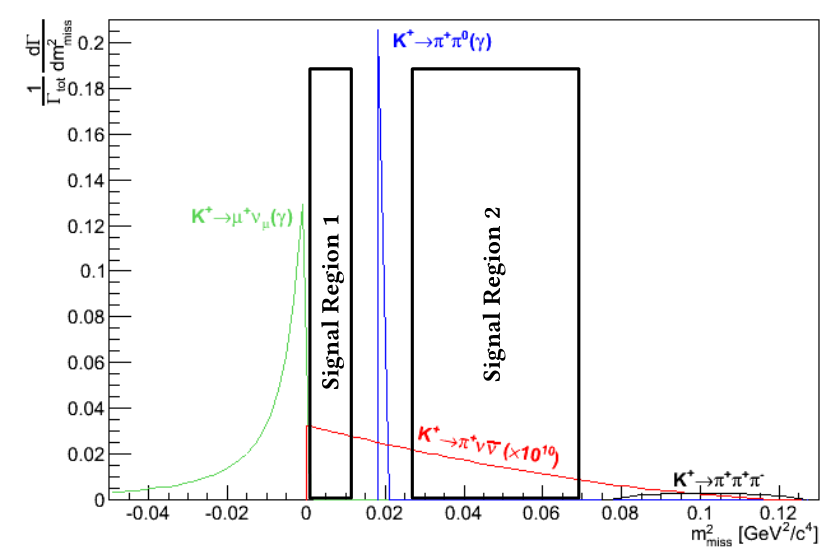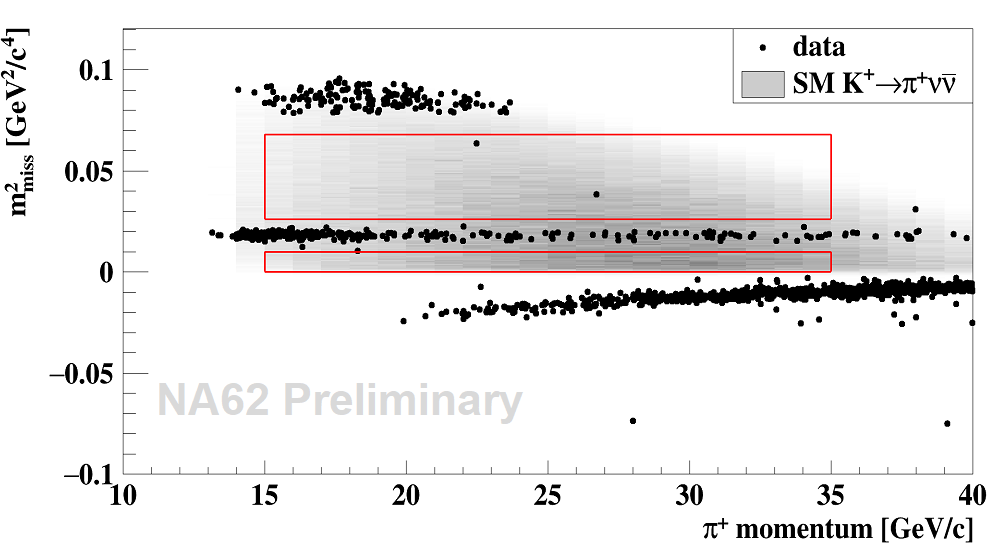NA62 experiment presents new results
The NA62 experiment presented the latest result on the search for the ultra-rare kaon decay K+ → π+νν ̄ using 2017 data at the KAON2019 Conference, at the Physics in Collision Conference and during a recent CERN's EP Seminar
Kaons, the lightest elementary particles containing the strange quark, have always been a copious source of information on the fundamental interactions. Kaons played a key role in establishing the foundation of the Standard Model (SM), and kaons fixed-target experiments (NA31, NA48) at the CERN Super Proton Synchroton (SPS) recorded the first evidence and then precisely measured direct charge-parity violation, the process ultimately responsible for the matter-antimatter asymmetry in the Universe.
Despite all its phenomenological successes, the Standard Model has some deep unsolved problems: for example, it offers no explanation for the mass hierarchy between the three fermion generations; it cannot predict the origin of matter-antimatter imbalance, nor the nature of dark matter. Extensions of the SM predict the existence of new particles or interactions, referred to as “new physics”. New physics at high-mass scales can reveal itself in dynamic effects at lower, accessible, energy like higher-order processes. When this happens, deviations from the SM predictions are observed. Higher-order processes are naturally suppressed in the SM, making them rare.
Flavour Changing Neutral Current transitions, such as K+ → π+νν ̄, are forbidden in the SM at the lower level (called tree level) and are sensitive to the presence of new virtual massive particles entering through higher order corrections to the leading order amplitudes, or via tree level processes mediated by new heavy gauge bosons [M. Blanke et al., EPJ C 76 (2016) no.4 182.]. They are therefore sensitive to energy scales much higher than those explored by LHC via direct searches. A precise measurement of the K+ → π+νν branching ratio would constrain a variety of New Physics models, for example it is sensitive to lepto-quark models [G. Isidori et al., EPJ C 77 (2017) 618.], i.e. models where new particles are expected that carry both lepton and baryon quantum numbers.
A precise measurement of the K+ → π+νν decay is the main goal of the NA62 experiment. This decay provides an outstanding means to search for new physics, since it is highly suppressed with a probability to occur of only about 8 out of 1011 kaon decays, while at the same time being precisely predicted in the Standard Model with a theory uncertainty of about 10% [A. J. Buras et al., JHEP 1411 (2014) 121.]. Because it is so precisely predicted in the SM, any small deviation from such predictions can be used to effectively confirm or constrain new physics models.
The experiment is located in CERN's North Area in the Prevessin site. The 400 GeV proton beam from the SPS impinges on a fixed beryllium target, producing a beam of hadrons. A system of collimators, magnets, and absorbers selects a monochromatic 75 GeV beam of positive particles, 6% of which are kaons. The signature of the K+ → π+νν ̄ signal is simply one incoming kaon decaying to a single-detected charged-pion track. A series of subdetectors (Figure 1) provide measurements of particle momentum, energy, and identification, and veto extra activity [JINST 12 P05025 2017]. Useful K+ decays are detected in a 65 m long decay region.

Figure 1: Schematic vertical section through the NA62 experimental setup. The main elements for the detection of the K+ decay products are located along a 150 m long region starting 121 m downstream of the kaon production target. Useful K+ decays are detected in a 65 m long decay region. Most detectors have an approximately cylindrical shape around the beam axis. An evacuated passage surrounding the beam trajectory allows the intense (750 MHz) flux of un-decayed beam particles to pass through without interacting with detector material before reaching the dump.
Both the incoming kaon and its decay products are measured, allowing for the signal event reconstruction and for identifying and rejecting all the other kaon decays, which is a very challenging task considering how rare the signal is. Kinematic rejection of the most abundant kaon decay modes is obtained by selecting two restricted regions (Region I and Region II, as shown in Figure 2) of the m2miss distribution defined as (PK – Pπ)2 where PK is the 4-momentum of the parent particle, assumed to be a kaon and Pπ is the 4-momentum of the decay particle, assumed to be a pion.

Figure 2: Distribution of missing mass squared for the signal (enhanced) and most abundant kaon decays. The two signal regions are clearly indicated as Region I and Region 2.
The experiment took data during 2016-2018 at increasing beam intensity. The result published last year on the 2016 data set established the experimental technique and set the first limit on the branching ratio of K+ → π+νν from NA62 [Phys. Lett. B 791, 156 (2019)]. The new result on 2017 data is obtained with a sample of about 2 1012 K+ decays. The Single Event Sensitivity (SES) is defined as the ratio of the SM K+ → π+νν branching ratio over the number of expected K+ → π+νν events. The SES for 2017 is 10 times better than for 2016 data and gives about 2 Standard Model events expected.
A great effort has been put in evaluating the expected background to the measurement, i.e. in identifying and quantifying the spurious events that, despite all the measures described above, might still leak into the signal region. Both data and simulation were used to this purpose. The analysis is performed “blindly”: the signal region is kept masked until the number of signal events and most importantly the number of background events are precisely evaluated, and checked using regions where the signal is negligible (so-called control regions).
The 2017 analysis included extensive checks on a variety of control regions where different types of background are enhanced, inverting or releasing specific selection criteria. Finally the expected background in the signal regions is calculated. The background sources can be divided into two categories: events due to common kaon decays happening in the decay region and escaping detection (source 1), and those due to decay happening before the decay region or due to beam particle interactions in the material and mimicking the signal (source 2). With the analysis techniques used for the 2017 data, source 1 amounts to about 0.6 events and source 2 to 0.9 events, for a total of 1.5 background events expected. At this stage in the analysis, the blind box was opened and the result revealed 2 events in Region 2 and zero events in Region 1 (Figure 3).

Figure 3: Distribution of missing mass squared versus pion momentum for 2017 data. The red boxes indicate the signal regions. There are two events in Region 2.
The 2017 result can be combined with the 2016 result since the analysis has been done in a totally compatible manner. The combined 2016 and 2017 result can be seen in Figure 4 as two-sided 68% band. The figure highlights the evolution of the theoretical predictions as well as the experimental measurements [Phys. Rev. D 77, 052003 (2008), Phys. Rev. D 79, 092004 (2009) for E787/E949 experiment; paper in preparation and KAON2019 Proceedings for NA62 experiment]. The observed Upper Limit at 90% confidence level is 1.85 10-10. The result achieves a higher precision than the previous measurement, is consistent with the Standard Model and constrains already New Physics models predicting the largest enhancements. This great achievement is the result of the team effort of all the collaborating institutes, and the continuous support of CERN as hosting institution and of the financial agencies.
Figure 4: Historical evolution of the prediction and measurement of the branching ratio of K+ → π+νν-.
The analysis of 2018 data, containing a sample twice as large as 2017, is in progress and the result is expected for next year. Ways to improve the signal acceptance and reduce the effect of accidental activity in the detector will be explored, as well as the use of the background shape versus the signal shape for kinematic variables.
The experiment is about to submit a beam request to CERN for data taking after the Long Shutdown 2, to complete its physics programme. There are plans to rearrange the beam setup in the GTK and achromat region to strongly suppress the background from source 2, and to take data at higher beam intensity.
